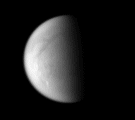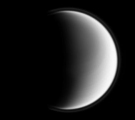Titan Fly-by - 27 March 2009
25 March 2009
Friday, 27 March, Cassini returns to Saturn's largest moon for the mission's fifty-second targeted encounter with Titan: Titan-51. The closest approach to Titan occurs at 04:43:36 UT, at an altitude of 960 kilometres above the surface and at a speed of 6.3 kilometres per second. The latitude at closest approach is 30.9°S and the encounter occurs on orbit number 106.This encounter is set up with two manoeuvres: an apoapsis manoeuvre on 8 March, and a Titan approach manoeuvre, scheduled for 23 March. T51 is the fifteenth and final fly-by in a series of outbound encounters and the seventh Titan encounter in Cassini's Equinox Mission. It occurs just over five days after Saturn closest approach.
Science Highlights
- Radio Science Subsystem (RSS)
RSS observes bistatic scattering from Titan's surface on the fly-by's outbound side. The observation probes the midnorthern latitude regions of Titan's surface (30-40°N, ~190-200° W). Same- and crosspolarized components of the quasi-specular surface echo, if detectable, provide information about the dielectric constant and physical state of the surface region probed. - Ion and Neutral Mass Spectrometer (INMS)
On T51, INMS is Prime on the fly-by's outbound leg. The observation is designed to measure the day side ionosphere, and the wake/outer flank of the magnetospheric interaction region. This pass fills in coverage of mid to high latitudes. - Visual and Infrared Mapping Spectrometer (VIMS)
VIMS will observe Ontario Lacus (75°S, 180°W) after the equinox and will be able to see any change from observations taken before the equinox. VIMS will also look for changes in the south pole area as it is less and less illuminated. The instrument will also monitor tropical clouds during the fly-by in an area west of Tsegihi (30-60°S, 60-100°W) at a resolution between 5 and 10 km per pixel. - Composite Infrared Spectrometer (CIRS)
CIRS will perform low southern latitude limb composition sounding, in the mid and far-infrared. - Ultraviolet Imaging Spectrograph (UVIS)
UVIS will obtain an image cube of Titan's atmosphere at EUV and FUV wavelengths by sweeping its slit across the disk. These cubes provide spectral and spatial information on nitrogen emissions, hydrogen emission and absorption, absorption by simple hydrocarbons, and the scattering properties of haze aerosols. This is one of many such cubes gathered over the course of the mission to provide latitude and seasonal coverage of Titan's middle atmosphere and stratosphere. - Imaging Science Subsystem (ISS)
ISS will acquire full-disk and global-mapping mosaics and high-resolution imaging of Titan's leading hemisphere at high southern latitudes. ISS will attempt very high-resolution imaging of the south-polar region, including Ontario Lacus, in ride-along with VIMS. - Magnetospheric Imaging Instrument (MIMI)
MIMI measures energetic ion and electron energy input to Titan's atmosphere. - Dual Technique Magnetometer (MAG)
T51 is another near-noon (10.5 h SLT), upstream flank-out fly-by, with a minimum altitude of < 1000 km, which is almost parallel to T50. Therefore, the measurements will be complementary to T50, providing a description of the draping and the pileup of the external magnetic field around Titan on the dayside hemisphere. As in the previous fly-bys, Titan could be found in the magnetosheath during T51. - Radio and Plasma Wave Science (RPWS)
RPWS will measure thermal plasmas in Titan's ionosphere and surrounding environment; search for lightning in Titan's atmosphere; and investigate the interaction of Titan with Saturn's magnetosphere.
Table of Events
24 March 2009
| Time UTC | Time wrt T-51 |
Activity |
| 01:20:00 | -03d 03h | OTM #184 prime. Titan-51 targeting manoeuvre |
25 March 2009
| Time UTC | Time wrt T-51 |
Activity |
| 01:05:00 | -02d 04h | OTM #184 backup |
26 March 2009
| Time UTC | Time wrt T-51 |
Activity |
| 10:05:00 | -18h 38m | Start of Sequence S49 that contains Titan-51 |
| 10:05:00 | -18h 38m | Start of the TOST segment |
| 10:11:00 | -18h 32m | Turn cameras to Titan |
| 10:53:00 | -17h 50m | New waypoint |
| 10:53:00 | -17h 50m | Deadtime, 7 minutes and 31 seconds long. Used to accommodate changes in fly-by time |
| 11:00:31 | -17h 43m | Titan atmospheric observations - CIRS. Obtain information on the thermal structure of Titan's stratosphere |
| 14:43:36 | -14h 00m |
Titan surface observations - ISS. |
| 16:43:36 | -12h 00m | Titan atmospheric observations - CIRS. Obtain information on CO, HCN, CH4. Integrate on disk at airmass 1.5-2.0 |
| 19:43:36 | -09h 00m | Titan global map - ISS. Monitoring for surface/atmosphere changes; attempt to see surface colour variations; monitor limb hazes |
| 23:43:36 | -05h 00m | Titan surface observations - VIMS. Regional map |
27 March 2009
| Time UTC | Time wrt T-51 |
Activity |
| 02:43:36 | -02h 00m | Titan Regional map - ISS. Monitoring for surface/atmosphere changes; attempt to see surface colour variations; monitor limb hazes |
| 03:51:36 | -00h 52m | Transition to thruster control |
| 03:52:36 | -00h 51m | Titan mosaic - VIMS. Path over Ontario lake 12 minutes before closest approach with images at 1.5 km/pixel |
| 04:43:36 | +00h 00m | Titan-51 Fly-by Closest Approach Time. Altitude = 960 km, speed = 6.3 kms-1, 84° phase at closest approach |
| 04:51:35 | +00h 08m | Apoapse |
| 04:58:36 | +00h 15m | Titan RSS observations. Bistatic scattering measurements at three radio wavelengths to determine the physical properties of Titan's surface, including reflectivity, dielectric constant, and roughness |
| 06:11:36 | +01h 28m | Transition off of thruster control |
| 06:32:43 | +01h 49m | Titan atmospheric observations - CIRS. Obtain information on surface & tropopause temperatures, and on tropospheric CH4 |
| 09:43:36 | +05h 00m | Titan atmospheric observations - CIRS. Obtain vertical profiles of temperatures in Titan's stratosphere |
| 13:43:36 | +09h 00m | Titan WAC photometry - ISS. Monitoring for surface/atmosphere changes; attempt to see surface colour variations; monitor limb hazes |
| 14:43:36 | +10h 00m | Titan atmospheric observations - CIRS. Obtain information on CO, HCN, CH4 |
| 05:09:51 | +00h 26m | Ascending ring plane crossing |
| 17:43:36 | +13h 00m | Nightside NAC imaging-ISS. Monitoring for surface/atmosphere changes; attempt to see surface colour variations; monitor limb hazes |
| 18:13:36 | +13h 30m | Titan atmospheric observations - CIRS. Obtain information on the thermal structure of Titan's stratosphere |
| 23:25:36 | +18h42m | Nightside NAC imaging - ISS. Monitoring for surface/atmosphere changes; attempt to see surface colour variations; monitor limb hazes |
| 23:55:36 | +19h 12m | Deadtime, 14 minutes and 23 seconds long. Used to accommodate changes in fly-by time |
28 March 2009
| Time UTC | Time wrt T-51 |
Activity |
| 00:10:00 | +19h 27m | Turn to Earth-line |
| 00:50:00 | +20h 07m | Playback of T51 data. Goldstone 70m ground station |
| 03:20:00 | +22h 37m | Playback of T51 data. Goldstone 34m ground station |
| 05:33:15 | +01d 01h | Periapse |
| 09:50:00 | +01d 05h | Playback of T51 data. Canberra 34m ground station |
Observation Results
Cassini Instrument: Imaging Science Subsystem (ISS)
Last Update: 1 September 2019


